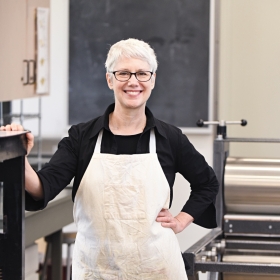The new printmaking studio where Phyllis McGibbon teaches boasts natural light, excellent ventilation, and a long, unbroken expanse of wall for displaying works in progress. Just as important, its proximity to new-media and other studios allows for collaboration.

Photo by Richard Howard
Art and teaching are so tightly interwoven in Phyllis McGibbon’s life that she finds herself thinking about students when she looks at art. “I’m thinking not just about what’s interesting to me, but I’m always trying to process work that might be interesting to a particular student I’m mentoring. I think, ‘So-and-so would like to see this,’” she says.
McGibbon’s generosity, combined with a thoughtful and constructive critique process in her studio-art classes, has brought her accolades. An artist who specializes in printmaking and a member of the art faculty since 1994, she was tenured and received the Pinanski Prize for Excellence in Teaching in 1997. Recently McGibbon was named Elizabeth Christy Kopf Professor of Art and wrapped up seven years as faculty client lead on the Pendleton West renovation project.
“I went into the renovation with a sense of wanting to give back,” she says, “so it’s really gratifying to see the building now and how it supports so many different kinds of work.”
Pendleton West was a “complex and multifaceted collaboration,” says colleague Katherine Ruffin, director of Book Studies and Book Arts. “Throughout the project, Phyllis maintained focus on the ways in which the new and improved studio spaces could enhance student learning.”
McGibbon made sure that students were included in every phase of the project. She invited them to early space-planning meetings and took them on hard-hat tours. As the building’s bones emerged, she encouraged them to take advantage of an “exercise in imaginative travel that would enhance their education,” McGibbon says. “The ability to reflect about change is very important.”
The new printmaking studio where McGibbon teaches—Dactyl Press, named in honor of benefactor and former Wellesley trustee Beth Pfeiffer ’73—boasts natural light, excellent ventilation, and a long, unbroken expanse of wall for displaying works in progress. Just as important, its proximity to new-media and other studios allows for collaboration. “That kind of informal studio learning—which was partly what drew me to printmaking in the first place—the way that people learn from each other as people as well as artists, that really does enhance creative work,” she says.
For McGibbon, artmaking is both a highly collaborative and deeply solitary pursuit. As an undergraduate at the University of Wisconsin, Madison, she was drawn to the buzz of activity around the presses. “It was kind of lonely in the painting studio by comparison,” she says. She began making lithographs and etchings and then moved on to artists’ books and installation projects. She was awarded numerous artist residencies and taught at several colleges and universities before coming to Wellesley.
Not only is McGibbon a highly regarded teacher, but she’s also a widely exhibited artist. Her work includes installations, prints, drawings, and artists’ books; the latter can be found in the collections of the Getty, Library of Congress, and Victoria and Albert Museum, among others. Her art has precise and delicate lines that convey an underlying wiry and tensile strength. Some of the work is directly inspired by Albrecht Dürer (1471–1528) and is etched into copper or screened onto a piece of cloth.
Achieving balance between her roles as educator and artist hasn’t been easy, particularly during the Pendleton West project. “I’ve been living from deadline to deadline and show to show,” McGibbon says. She’s looking forward to a yearlong sabbatical starting in fall 2019, when she’ll have time to contemplate the next direction in her work.
Her conversation in an interview drifts naturally back to students. She learned recently through a colleague that a group of her students at an international printmaking conference had impressed one of the exhibitors. The exhibitor emailed to say that the Wellesley students had taken the time to look at everything and had asked “a million questions.”
“It made me so happy, because no matter what they do in life, they’re going to be fully engaged, with a kind of confidence, and curiosity, and enjoyment and excitement about learning,” she says. “That’s what we’re after.”
